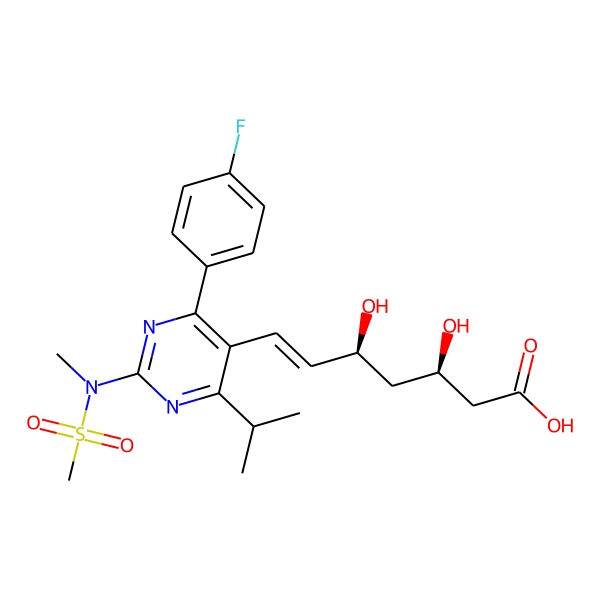Rosuvastatin
Function
DrugBank ID:
Description:
Rosuvastatin, also known as the brand name product Crestor, is a lipid-lowering drug that belongs to the statin class of medications, which are used to lower the risk of cardiovascular disease and manage elevated lipid levels by inhibiting the endogenous production of cholesterol in the liver. More specifically, statin medications competitively inhibit the enzyme hydroxymethylglutaryl-coenzyme A (HMG-CoA) Reductase,which catalyzes the conversion of HMG-CoA to mevalonic acid and is the third step in a sequence of metabolic reactions involved in the production of several compounds involved in lipid metabolism and transport including cholesterol, low-density lipoprotein (LDL) (sometimes referred to as "bad cholesterol"), and very low-density lipoprotein (VLDL). Prescribing of statin medications is considered standard practice following any cardiovascular events and for people with a moderate to high risk of development of CVD, such as those with Type 2 Diabetes. The clear evidence of the benefit of statin use coupled with very minimal side effects or long term effects has resulted in this class becoming one of the most widely prescribed medications in North America.Rosuvastatin and other drugs from the statin class of medications includingatorvastatin,pravastatin,simvastatin,fluvastatin, andlovastatinare considered first-line options for the treatment of dyslipidemia.This is largely due to the fact that cardiovascular disease (CVD), which includes heart attack, atherosclerosis, angina, peripheral artery disease, and stroke, has become a leading cause of death in high-income countries and a major cause of morbidity around the world.Elevated cholesterol levels, and in particular, elevated low-density lipoprotein (LDL) levels, are an important risk factor for the development of CVD.Use of statins to target and reduce LDL levels has been shown in a number of landmark studies to significantly reduce the risk of development of CVD and all-cause mortality.Statins are considered a cost-effective treatment option for CVD due to their evidence of reducing all-cause mortality including fatal and non-fatal CVD as well as the need for surgical revascularization or angioplasty following a heart attack.Evidence has shown that even for low-risk individuals (with <10% risk of a major vascular event occurring within 5 years) statins cause a 20%-22% relative reduction in major cardiovascular events (heart attack, stroke, coronary revascularization, and coronary death) for every 1 mmol/L reduction in LDL without any significant side effects or risks.While all statin medications are considered equally effective from a clinical standpoint, rosuvastatin is considered the most potent; doses of 10 to 40mg rosuvastatin per day were found in clinical studies to result in a 45.8% to 54.6% decreases in LDL cholesterol levels, which is about three-fold more potent thanatorvastatin's effects on LDL cholesterol.However, the results of the SATURN trialconcluded that despite this difference in potency, there was no difference in their effect on the progression of coronary atherosclerosis.Rosuvastatin is also a unique member of the class of statins due to its high hydrophilicity which increases hepatic uptake at the site of action, low bioavailability, and minimal metabolism via the Cytochrome P450 system.This last point results in less risk of drug-drug interactions compared toatorvastatin,lovastatin, andsimvastatin, which are all extensively metabolized by Cytochrome P450 (CYP) 3A4, an enzyme involved in the metabolism of many commonly used drugs.Drugs such asciclosporin,gemfibrozil, and some antiretrovirals are more likely to interact with this statin through antagonism of OATP1B1 organic anion transporter protein 1B1-mediated hepatic uptake of rosuvastatin. [DrugBank]
Targets:
3-hydroxy-3-methylglutaryl-coenzyme A reductase (Humans); Integrin alpha-L (Humans) [DrugBank]
Pharmacodynamics:
Rosuvastatin is a synthetic, enantiomerically pure antilipemic agent. It is used to lower total cholesterol, low density lipoprotein-cholesterol (LDL-C), apolipoprotein B (apoB), non-high density lipoprotein-cholesterol (non-HDL-C), and trigleride (TG) plasma concentrations while increasing HDL-C concentrations. High LDL-C, low HDL-C and high TG concentrations in the plasma are associated with increased risk of atherosclerosis and cardiovascular disease. The total cholesterol to HDL-C ratio is a strong predictor of coronary artery disease and high ratios are associated with higher risk of disease. Increased levels of HDL-C are associated with lower cardiovascular risk. By decreasing LDL-C and TG and increasing HDL-C, rosuvastatin reduces the risk of cardiovascular morbidity and mortality.15,21 [DrugBank]
Structures
Docking in target protein
Off-target analysis based on ligand similarity (Homo sapiens)
Step 1 - Target prediction for Rosuvastatin: SwissTargetPrediction
Tips: Click on the link to jump to the 'SwissTargetPrediction' webserver. Select the species of 'Homo sapiens', and then paste the SMILES of Rosuvastatin in the SMILES input box.
Step 2 - Blind docking for Rosuvastatin: CB-Dock
Tips: Click on the link to jump to the 'CB-Dock' webserver. Upload the structure file of target predicted by 'SwissTargetPrediction' and the 2D/3D structure file of Rosuvastatin to perform blind docking.
